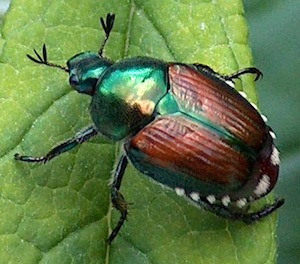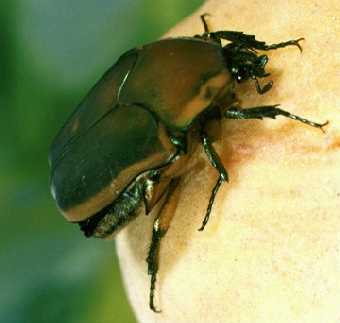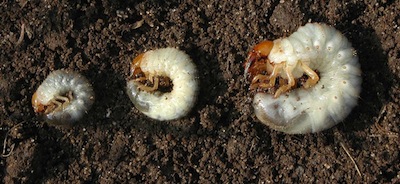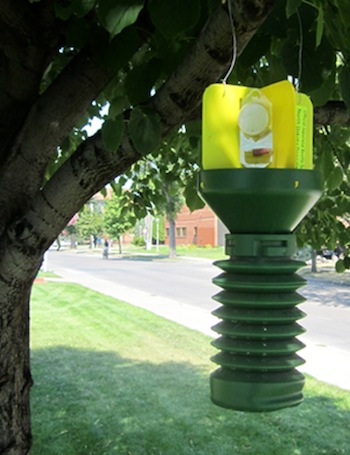Grubs and Beetles: What to Do with These Pests
| By Sharon Vaughan Smith, former Fairfax Master Gardener In early spring, we begin cleaning out our gardens and ornamental beds of leaves, twigs and debris. As we work, we till up the soil and discover C-shaped white- to cream-bodied worm-looking pests with tan or brown heads. In July and August, when the weather is at its hottest with the harvest of blueberries, blackberries and raspberries, we come across some unwelcomed beetles enjoying the fruits of our labor (no pun intended).In late August, a brown patch in our lawn catches our eye. We noticed it has been dry, so we believe the dieback is due to lack of water and scorching heat. By October, we see several crows hanging out in the yard, and we catch a hint in the air that a skunk has been visiting, too. We observe that the irregularly-sized brown patch in the lawn has gotten bigger and that we can easily pull up the brown turf in large pieces.What could be causing these problems? It is the result of three beetles that are members of the scarab beetle family.
|
 Japanese beetle  Green June beetle  Masked chafer beetle |
Identifying which beetle you may have begins with a close inspection of the grub’s underside, specifically the last abdominal segment’s raster pattern (arrangement of coarse hairs). A V-shaped raster pattern is a Japanese beetle, a pattern of two irregular rows is a Green June beetle, and the Northern Masked Chafer has no discernible pattern. The adults vary as well with the Japanese beetle measuring about one-half inch long, metallic green to bronze with coppery red wings and small white tufts on the side and tip of the abdomen. The Green June beetle is 1 inch long, one-half inch wide and flat on the top. It is a dull velvety green color with deep yellow to bronze margins and metallic green below. The Northern Masked Chafer is chestnut brown, about one-half inch long and covered with fine hairs.
 The grubs of the Japanese beetle and Northern Masked Chafer will overwinter in the soil 8 to 10 inches deep. The Green June beetle grub can be found a foot or more deeper in the soil. As the spring temperatures increase and warm up the soil, the grubs of the Japanese beetle, and Northern Masked Chafer move up in the soil to feed on grass roots while the grubs of Green June beetle feed mainly on decaying plant matter.
The grubs of the Japanese beetle and Northern Masked Chafer will overwinter in the soil 8 to 10 inches deep. The Green June beetle grub can be found a foot or more deeper in the soil. As the spring temperatures increase and warm up the soil, the grubs of the Japanese beetle, and Northern Masked Chafer move up in the soil to feed on grass roots while the grubs of Green June beetle feed mainly on decaying plant matter.
In late June to August, the adult beetles emerge from the pupa stage as Japanese beetles, Green June beetles or Masked Chafers. The voracious eaters, Japanese and Green June beetles, can be found dining on 300 plant species, often feeding in groups. They chew holes in leaves between the leaf veins, giving the leaves a lacy appearance called skeletonizing. The adult Masked Chafer, on the other hand, does not feed on plants, yet as a grub is the most widespread and destructive insect pest of turf in the northern two-thirds of the United States. It feeds on organic matter, cool-season (Kentucky bluegrass, rye and tall fescue) and warm-season (Zoysia, Bermuda) grasses. As the Masked Chafer grubs eat the roots, the turf turns brown and can easily be pulled up in large pieces. Many times, the insectivores (crows, raccoons, skunks, etc.) do further damage while digging for the tasty white morsels.

Japanese beetle grub
The best time to treat the grubs is when they are young and most vulnerable, not in the spring when they are large. With a 12-month life cycle, most beetle eggs will be hatched by early August. Applying a chemical insecticide treatment in mid-summer is optimal. (See 2021 VA Pest Management Guide, Table 5-2 for approved insecticides.) Treatment also can be based on historical monitoring and current season beetle population. An organic control, pyrethrin-based insecticide, derived from dried chrysanthemum flowers (Chrysanthemum cinerariifolium), attacks the nervous system of all insects and has been found to be an effective way to control beetles on grapes, raspberries, flowers, roses, trees and shrubs. Generally ineffective controls are insecticidal soap, extracts of garlic, hot pepper or orange peels, and companion planting. As with all treatments, read the labels and follow all label precautions before using.
When it comes to lawn health, a well-maintained lawn can tolerate more larvae than one that is stressed due to heat, drought, improper mowing height and lack of fertilizer. The use of nitrogen fertilization in the fall in the damaged areas of the lawn will help it to recover. Appropriate irrigation in late summer or early fall will encourage root regrowth and aid in grass tolerance to feeding. Another option, which seems contradictory, is to keep irrigation to a minimum in July and August since female beetles prefer to lay their eggs in moist, well-drained soil in a sunny location. Without irrigation and very little rain, the eggs should dry out and die. Finally, increasing mowing height 3 to 3 1/2 inches for fescue type grasses and 1 ½ to 2 inches for Zoysia and Bermuda may help turf tolerance. Taller grass harbors more natural enemies of the grub eggs. Turf aeration may also kill as many as 40 percent of grubs.
Biological control approaches include the use of entomopathogens, which are bacteria, fungi and nematodes, as well as insect predators and parasitoids. Using the entomopathogenic nematode (Heterorhabditis spp.) can be a very effective control when applied to soil as a drench to control larvae, since it penetrates the body of the grub.
Another popular biological control sold at big box stores is milky spore, yet it is only works on Japanese beetle grubs, and test results indicate varying effectiveness. If applied, no insecticides can be used for two to three years afterward, since enough Japanese beetles need to be present for the disease agent to build up.

Japanese beetle trap
Beetle traps are an effective way of attracting and capturing beetles. The chemical eugenol attracts both female and male beetles. The bags are best used when the adults first emerge. It is important to use multiple trap bags. Locate them 30 to 40 feet from the plants you wish to protect. Be aware that more damage to landscape will occur from beetles attracted by the traps. Research has shown that the traps attract many more beetles than are actually caught. If you plan to use them, it is highly recommended that they be emptied regularly to be effective.
The last option involves getting an early start on the day and a bucket of soapy water. Beetles are sluggish in the morning so by putting a dropcloth under the plants that are being enjoyed and giving the plant or limbs a little shake, the beetles will fall to the ground on the dropcloth. From there, you simply scoop them up and put them in a bucket of water with a tablespoon of dishwashing liquid and eventually they will drown. You could also try shaking the limb or branch while positioning the soapy water bucket underneath, and they will fall directly into it. The simplest method is to just hand pick the beetles off and discard them one by one into your bucket. Removing beetles and not allowing them to gather will make the plant less attractive to other beetles.
In conclusion, the economic threshold level of six to 10 larvae per square foot has been generally used as a guide to determine if treatment is warranted. Treatment is something for you or your lawn care professional to determine after a thorough discussion. Keep in mind that pests are a normal part of gardening. It can be disappointing to discover an unwanted pest, yet the joy of gardening is always much greater than the challenges.
References
• Beetlemania – White Grub Control in Lawns, Virginia Cooperative Extension Office
• Biology, Ecology, and Management of Masked Chafer (Coleoptera: Scarabaeidae) Grubs in Turfgrass
S. Gyawaly, A. M. Koppenhöfer, S. Wu, T. P. Kuhar
• JIPM Article on Masked Chafer Grubs in Turfgrass Explains Management Techniques, Entomology
Today, February 10, 2016, Leslie Mertz
• ENTFACT-451: Japanese Beetles in the Urban Landscape, M.F. Potter, D.A. Potter, and
L.H. Townsend, Extension Entomologists, University of Kentucky College of Agriculture
…updated 2021